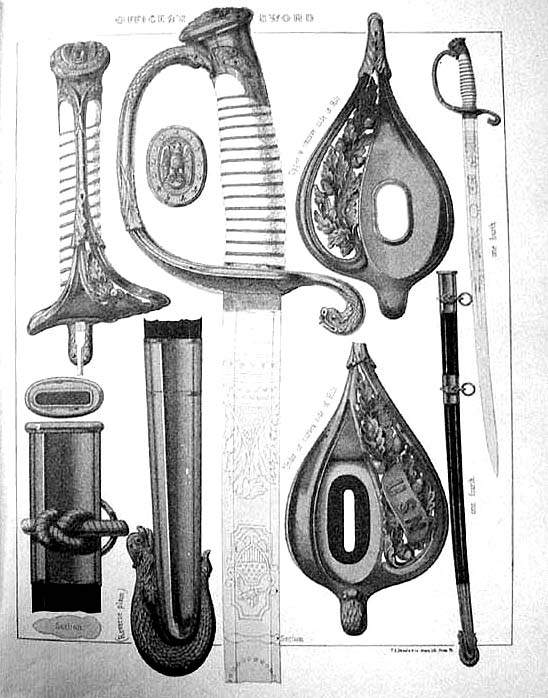
This is a rare example of a 19th Century M1852 Naval officer’s
sword of a pedigreed American maker. It is a special find.
DIMENSION
SUMMARY: Blade: 7/8 inch wide, 1/4 inch thick, 28 inches long
Hilt 5 3/4 inches long. Length overall 33 1/2 inches. In scabbard 34 inches.
Primary Fuller 20 3/4” x 3/4“ Weight sword in scabbard 2 Lbs
14 oz Net 1 lb 14 oz Sword Knot 38 grams or 1.22 Troy
ounces of Gold.
The antique gold bullion high
ranking officer sword knot is not included.Presented
is a very rare, high quality, M1852 Naval Officer’s sword that was made prior to 1883 by the famous German Solingen
swordmaker, Weyersberg to Horstmann’s order. It has a slightly curved pipeback blade with two fullers, which was common
to the Navy’s M 1841 eagle pommel sword design, and was carried forward by Horstmann in this model sword. This sets the
Horstmann swords apart from most others. The design on this sword’s blade is described in detail below.THE BLADE is 28 inches long by 7/8 inches wide and is 1/4 inch thick on the spine which is marked
IRON PROOF and elsewhere covered in flora. The primary fuller is 7/16 inch wide and runs 20 3/4 inches over which
is a 1/8 inch wide fuller that runs 17 1/2 inches. It is etched over 15 1/2 inches of its length. The reverse ricasso
is stamped with the Weyersberg king’s head which was used until 1883 when that company merged with Kirschbaum. Above the
obverse ricasso and as part of the design is etched horizontally, Horstmann & Sons, Philadelphia, on three lines.Originally, it was
polished with a frosted design, but the polishing has faded with age. It is now a light grey with only
mild spotting, light handling marks, and strong etching. The cutting edge is unsharpened and without nicks. The faded
red washer appears original.
spine.Right above the Horstmann name is
a swirl of leaves 2 3/4 inch long, culminating in a rectangular design with a double border within which is a fouled
anchor with American shield on its shaft. Above that is an ellipse with thirteen stars with no name. Next is a group
of arms with pikes and battle axes topped by a pennant with USN.. The design ends with a sunburst.On the blade’s
reverse is a geometric band 1 1/2 inch long of alternating swirls and double lines. Above that is a large 2 1/4
inch American eagle facing left perched on a ship’s cannon barrel. Next is a large fowled anchor shown in 3/4 view
from the left. Then comes an ornate border and USN. The design continues with a square knot with an acorn
at the lower end, and then a series of oak leaves with the three strand line passing through and ending with another acorn
at the bitter end, and lastly a sunburst. Considering its age and service, the blade is in very good condition.
helps date it.THE HILT:
is 5 3/4 inches long ending in an engraved pommel with an end cap of a left facing eagle indicating foreign manufacture
which is surrounded by ten stars with the tang protruding though its chest. The number of stars in the official
1852 design is 13. The grip is wrapped in white shark skin (shargreen) with fourteen turns of double twisted
copper wire. The half basket guard is per the pattern with forward facing sea serpent quillion flowing into a pierced
guard with floral oak leaves acorns and USN emblazoned on the obverse and the oak leaves and acorns repeated on the reverse.
The lower hand guard terminates in an ornate sea serpent. It is slotted for a sword knot or portapee which
is added when the sword is worn. Most of the gold wash remains with some minor stains. The shark skin
wrap is in excellent condition.
leafs on front guard and oak leaves on the back. Sharkskin grip is and wrap is excellent
perfect scabbard.THE SCABBARD:
is 28 1/2 inches long by 1 1/4 inches wide at the throat. It is made of leather as called for by the 1852 Regulations.
It has heavily chased figure eight knots on its upper mounts each having a suspension ring. The leather is in very good condition with
all stitching tight. There is some light scuffing on the inner side. Most of the gold wash is gone. The sea serpent
on the drag is mounted with the head on the side with the rings. The serpent design is cast on both sides.
Length overall when the sword is housed, 34 inches.
The only difference
between the original Model 1852 sword design shown on the left, and that authorized today, is that in some today, materials
such as plastic instead of fish and ray skin, and lower quality metalwork are being used. Not so with this sword which
is of exceptional quality and conforms with the original specifications as follows:* From
1 1/8 inches to about 1 inch after 1872* To about
3/4 to 7/8 inch in the later 19th Century,* To 5/8
inch in today’s Navy.The regulation of
1852 had the eagle on the pommel facing right when viewed from behind. The use of the officer’s sword was suspended on
15 October 1942 and was not authorized officially again until 1954. Source Naval Historical and Heritage Command.HORSTMANN NAMES, DATES &
LOCATIONS:W.H. Horstmann & Sons
Horstmann Bros. & Allien
NY – 1852-77 Phila
– 1843 to 1863W.H. Horstmann & Co
Horstmann/Philadelphia
1893-1935
Phila 1859 – 1863
NY – 1850-52











